Are you a Quiet Speculation member?
If not, now is a perfect time to join up! Our powerful tools, breaking-news analysis, and exclusive Discord channel will make sure you stay up to date and ahead of the curve.
Ah, spoiler season. The time when I don't have to stretch myself doing statistical work. Just looking at the new cards, doing some basic analysis, and speculating about whether there's a place in Modern for them. Simple and low-pressure, just what this year's called for. Then, something had to come in a ruin everything: a card that appears tailor-made for Modern, something that a pet deck of mine has longed for, and yet, upon testing, has yielded conflicting data. I'm talking about Confounding Conundrum. And it's a frustrating card. It both does and does not work the way everyone thinks it does.

Hate pieces in general are pretty hard to evaluate. Their value depends on not only the prevalence of whatever they're targeting, but of the counterplay available. Rest in Peace seemed lethal against Hogaak, Arisen Necropolis decks, as they couldn't operate without their graveyards. However, it was useless in context due to Hogaak's speed as well as Force of Vigor. Enchantment removal is generally less played than artifact removal, making it more persistent, but the effects tend to be more narrow.
Confounding Conundrum is not only an enchantment hate piece against many cards and strategies, but a potentially maindeckable one. Which provides far more opportunities, but also exposes a lot of problems. I'll conclude that Conundrum is Modern-playable... asterisk.
About Confounding Conundrum
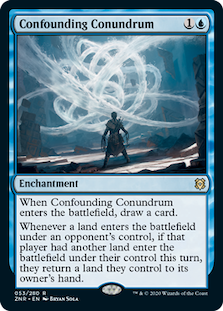 By now, everyone's seen the card because, at minimum, you see it alongside this paragraph. And there is a lot of text to work through then try and wrap the mind around.
By now, everyone's seen the card because, at minimum, you see it alongside this paragraph. And there is a lot of text to work through then try and wrap the mind around.
Whenever a land enters the battlefield under an opponent's control, if that player had another land enter the battlefield under their control this turn, they return a land they control to its owner's hand.
Confounding Conundrum is a land hate card. Specifically, it's designed to hate ramp by ensuring that opponent's can only play the single land per turn the rules allow. Every additional land played per turn can only replace a land currently on the battlefield, ensuring equity. I'd expect this type of effect to be white, but blue does have a history of bouncing lands dating back to Boomerang, and the formatting is decidedly blue. Opponent's don't have to return the offending land, just a land. This will be important later.
When Confounding Conundrum enters the battlefield, draw a card.
I'm not being facetious here; Conundrum being a cantrip is very important. We've seen Growth Spiral, Manamorphose, and Veil of Summer, which have mediocre primary effects, become powerhouses thanks to cantripping. At minimum, Conundrum always cycles, which puts it into consideration as a maindeck card. We haven't seen this on a land hate card since Blood Sun, which never quite lived up to expectations. Not because Sun is unplayable, but the meta has never needed that type of effect. That may not be true of Conundrum.
How it Works
Conundrum is counting lands. When it sees more than one land in a turn, it triggers. The trigger will go onto the stack before the opponent can use the land. They're free to tap the land at this point, but can't cast any sorcery speed spells until the trigger resolves. This being a triggered ability, multiple Conundrums mean multiple triggers.
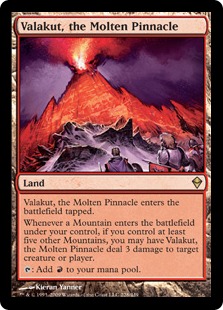 The final note is that triggers go onto the stack active-player-first, so any triggers the opponent may get from the extra land entering the battlefield happen after a land has been bounced by Conundrum. This in turn means that Conundrum effectively answers all the payoffs for all the Primeval Titan decks. Valakut, the Molten Pinnacle and Field of the Dead are looking for certain conditions to be met when they trigger and when they resolve (the intervening "if" clause). Both lands trigger when the conditions are met, then Conundrum's trigger goes on the stack and resolves first. If Conundrum leaves less than 5 other mountains or 7 lands with different names on the battlefield, the abilities fizzle. If they Scapeshift, then all the lands will have to be bounced for a really bad time. By the same token, Amulet must bounce a land before Amulet of Vigor can untap the karoo.
The final note is that triggers go onto the stack active-player-first, so any triggers the opponent may get from the extra land entering the battlefield happen after a land has been bounced by Conundrum. This in turn means that Conundrum effectively answers all the payoffs for all the Primeval Titan decks. Valakut, the Molten Pinnacle and Field of the Dead are looking for certain conditions to be met when they trigger and when they resolve (the intervening "if" clause). Both lands trigger when the conditions are met, then Conundrum's trigger goes on the stack and resolves first. If Conundrum leaves less than 5 other mountains or 7 lands with different names on the battlefield, the abilities fizzle. If they Scapeshift, then all the lands will have to be bounced for a really bad time. By the same token, Amulet must bounce a land before Amulet of Vigor can untap the karoo.
Also worth noting: Conundrum sees fetchlands as the allowed land drop. Cracking them on the same turn will trigger Conundrum. In this way, the enchantment gently hates on almost every deck.
An Exploit
The source of the new land is irrelevant. Two lands hitting in a turn is all that it takes for Conundrum to trigger. So Path to Exile and Field of Ruin count. Field is particularly exciting, as Conundrum turns it into better Dust Bowl. Much like pairing these cards with Leonin Arbiter, there is considerable potential in abusing Conundrum as a taxing piece. And unlike Arbiter, Conundrum isn't symmetrical.
A Problem
There are two problems with all of this. The first is the phrase "fail to find." A player can always fail to find when searching for a specific thing in any zone that is unknown information. They have to do anything else involved in the search (shuffling, mostly), but they never have to pick anything. Thus, a ramp player doesn't have to actually find a land when they search for one. I don't know why they wouldn't, as even though they have to 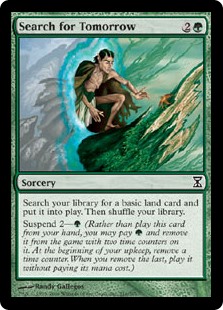 bounce a land afterwards, they've at least ensured they'll have their next land drop. They can also resolve their Search for Tomorrow and not play another land that turn. With only one Conundrum out, this is a bit of a wash, and will only be relevant with several Conundrums out; indeed, fully resolving Search and triggering two Conundrums sets players back on mana development, making a fail preferable.
bounce a land afterwards, they've at least ensured they'll have their next land drop. They can also resolve their Search for Tomorrow and not play another land that turn. With only one Conundrum out, this is a bit of a wash, and will only be relevant with several Conundrums out; indeed, fully resolving Search and triggering two Conundrums sets players back on mana development, making a fail preferable.
The second problem is that this isn't too hard to play around for most decks. They just have to not play more than one land on the same turn, and that's not too hard with smart sequencing. Decks with fetchlands can always just not crack them on their turn. This is standard practice for many decks anyway. Creature decks can skip their land drop until after combat in case of a Path. Valakut will crack their Sakura-Tribe Elder or Khalni Heart Expedition on their opponent's turn and ramp away. Plus, every deck misses land drops sometimes. Conundrum isn't going to surprise any opponent as long as they're actually paying attention, so don't assume that it will ever return lands. It's more of a threat than a reality.
On the Legacy subreddit, I saw someone call Conundrum a slow Sphere of Resistance. I agree with the sentiment, but would categorize it more as a slow Damping Sphere. Conundrum does nothing to affect any deck's ability to play spells in a given turn. It affects the subsequent turns. Go ahead and crack a fetch into Conundrum, float the mana, bounce a land, then cast whatever. The next turn is when the tax is applied, because of the bounced land.
In Modern's Context
Being solid in a vacuum is all well and good, but what matters is reality. I can wax speculative all I like, but the real test is when a card is actually tested. So that's exactly what I've been doing. I've decided test the maindeck potential of Confounding Conundrum, and to get the most out of it required a taxes shell. I'm no stranger to UW taxing decks, and have tried to 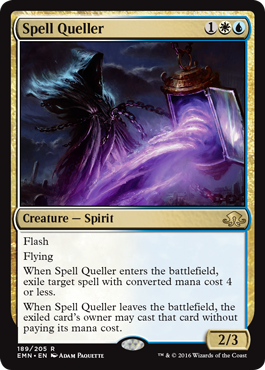 make Spirits and Taxes work a few times. It never really worked out in the past as the deck, was incredibly anemic and fairly schizophrenic due to the Spirits portion not jibing well with the Taxes side, and the mana was always all over the place. However, Xurikk 5-0'd a League with Spirits and Taxes, so I just took that list, arbitrarily replaced the Deputy of Detentions with Conundrum, and got to work.
make Spirits and Taxes work a few times. It never really worked out in the past as the deck, was incredibly anemic and fairly schizophrenic due to the Spirits portion not jibing well with the Taxes side, and the mana was always all over the place. However, Xurikk 5-0'd a League with Spirits and Taxes, so I just took that list, arbitrarily replaced the Deputy of Detentions with Conundrum, and got to work.
I'm not going to post a list because, of course, the deck wasn't very good. I went through a few iterations, but no change seemed to improve anything. That said, it was an ideal test platform, and it is from that testing that I can say that Modern has a place for Conundrum.
Testing Results
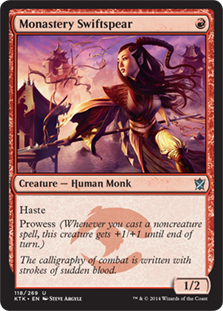 Conundrum is not good against Prowess decks. This shouldn't be much of a surprise as the tempo-negative Spreading Seas was never good against Burn, even though it usually took out one of their mana sources. Against Izzet and Rakdos, Conundrum hitting fetchlands does slow down the explosive attack. However, Prowess is still free to use fetched mana to play spells, and all I did was spread out the pain. There were a few times Conundrum slowed Prowess down enough to stabilize, but they were far outweighed by the times I lost to playing a do-nothing cantrip instead of a creature.
Conundrum is not good against Prowess decks. This shouldn't be much of a surprise as the tempo-negative Spreading Seas was never good against Burn, even though it usually took out one of their mana sources. Against Izzet and Rakdos, Conundrum hitting fetchlands does slow down the explosive attack. However, Prowess is still free to use fetched mana to play spells, and all I did was spread out the pain. There were a few times Conundrum slowed Prowess down enough to stabilize, but they were far outweighed by the times I lost to playing a do-nothing cantrip instead of a creature.
Additionally, Conundrum does nothing particularly great against the metagame's main ramp deck, Tron. Neither variant ever plays more than one land a turn. It is very dangerous to wait for a land drop before activating Field of Ruin against Mono-Green Tron. It's usually pointless to do so against Eldrazi Tron. There are instances where G-Tron was having a bad day and Conundrum made it worse, but for the most part it was worse than Seas would have been. Ponza was in the same boat.
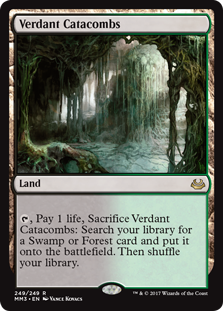 Against Jund and Wilderness Reclamation decks, Conundrum showed potential. Both decks play lots of fetchlands and like to use all their mana in a turn. Temur also runs acceleration sometimes. This meant that both had to really think about playing into Conundrum and reevaluate their gameplans. It was especially hard for Jund, given its playstyle, and a lot of mana was left on the table. This was not even getting into Path and Field suddenly having no drawbacks. As might be expected, mana disruption is more effective against slower fair decks.
Against Jund and Wilderness Reclamation decks, Conundrum showed potential. Both decks play lots of fetchlands and like to use all their mana in a turn. Temur also runs acceleration sometimes. This meant that both had to really think about playing into Conundrum and reevaluate their gameplans. It was especially hard for Jund, given its playstyle, and a lot of mana was left on the table. This was not even getting into Path and Field suddenly having no drawbacks. As might be expected, mana disruption is more effective against slower fair decks.
Conundrum was a beating and a third against the various versions of Valakut I tested. There's a whole spectrum from traditional Scapeshift decks to Vial Titan and Conundrum ruins all of them. Titan, Golos, Tireless Pilgrim, and Dryad of the Ilysian Grove are just land selection rather than ramp, while Sakura-Tribe and Elvish Reclaimer must be used on the opponent's turn only. Worse, there's simply way to just win with Valakut and, for once in its existence, it can only be the gradual value engine it was intended to be, and not a combo kill. Just a horrible wrench in the gears.
So, About that Asterisk
Observant readers have noticed that I skipped over Amulet Titan and more importantly Uro, Titan of Nature's Wrath. Conundrum does appear to particularly target Uro. Which is also what most of the hype is about. So, why so cagey?
These are the decks behind my opening-statement asterisk. My testing against both didn't go as expected. Something very strange happened when testing against Amulet that makes me nervous ever playing Conundrum against it again. And as for Uro...
First, It Gets Dangerous
Even if you get out Conundrum on turn 2, I didn't notice it having much effect. Uro decks durdle and are heavy on counterspells. They're fine cracking fetchlands on opponent's turns to not trigger Conundrum. Growth Spiral is an instant too, and is usually played on opponent's end steps anyway, so there's not a ton of disruption happening. I didn't really benefit much playing Conundrum, other than Field activations.
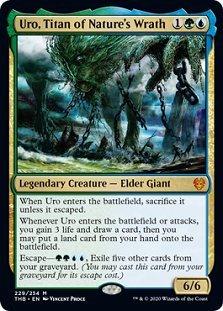 What about against Uro itself? Well, that's where it got complicated. Yes, stopping the ramp was decent. However, even when opponent's declined to put a land into play, Uro was still gaining three life and drawing a card. And preventing Hour of Promise from swamping me wasn't nothing. The problem was as the game went on, Conundrum makes it slightly easier to start looping Mystic Sanctuary. It was frequently correct later in the game to deliberately trigger Conundrum to recycle Sanctuary without burning Cryptic Command. And that felt really bad.
What about against Uro itself? Well, that's where it got complicated. Yes, stopping the ramp was decent. However, even when opponent's declined to put a land into play, Uro was still gaining three life and drawing a card. And preventing Hour of Promise from swamping me wasn't nothing. The problem was as the game went on, Conundrum makes it slightly easier to start looping Mystic Sanctuary. It was frequently correct later in the game to deliberately trigger Conundrum to recycle Sanctuary without burning Cryptic Command. And that felt really bad.
Admittedly, by that time, the game was pretty well lost, and the extra Sanctuary triggers were the door locking rather than closing. However, the fact remains that by lengthening the game, Uro started to benefit from my hate card. That shouldn't happen, and makes me leery of Conundrum in the current metagame.
Then, It Gets Weird
Meanwhile, the Amulet matchup mostly played out as expected. As I said, Conundrum answers Amulet of Vigor. It also hits Azusa, Lost but Seeking. It's a very strong hate piece here, arguably better than Damping Sphere. However, during a test game, something weird happened.
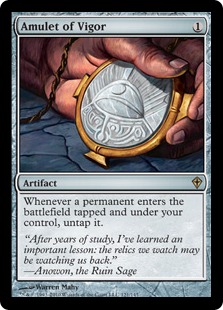 With two Sakura-Tribe Scouts, Azusa, Amulet, and five lands out against my Conundrum, Amulet played Simic Growth Chamber. Then started going off. As in, Summer Bloom going off. Using the Karoo bounce triggers, Amulet kept replaying the Chamber, returning the other lands, and floating the mana for Primeval Titan. Titan found Gemstone Mine and Slayer's Stronghold, let them be bounced, then used a Scout to replay the Stronghold, used floating mana to activate it, and swung. In the end, Titan was a mana short of the Sunhome, Fortress of the Legion kill. And that felt like a sequencing error.
With two Sakura-Tribe Scouts, Azusa, Amulet, and five lands out against my Conundrum, Amulet played Simic Growth Chamber. Then started going off. As in, Summer Bloom going off. Using the Karoo bounce triggers, Amulet kept replaying the Chamber, returning the other lands, and floating the mana for Primeval Titan. Titan found Gemstone Mine and Slayer's Stronghold, let them be bounced, then used a Scout to replay the Stronghold, used floating mana to activate it, and swung. In the end, Titan was a mana short of the Sunhome, Fortress of the Legion kill. And that felt like a sequencing error.
That only happened once. But it did happen. Couple that with the Uro results, and I can't give an unequivocal recommendation for Confounding Conundrum. It has its uses, and in the right metagame it will be devastating. Right now? It's potentially more of a liability.
Positing Positioning
In a world full of Primeval Titan, I think that Conundrum is a slam-dunk sideboard card, possibly making its way into the main to randomly screw fetchlands. But in the current metagame, I'd steer clear.


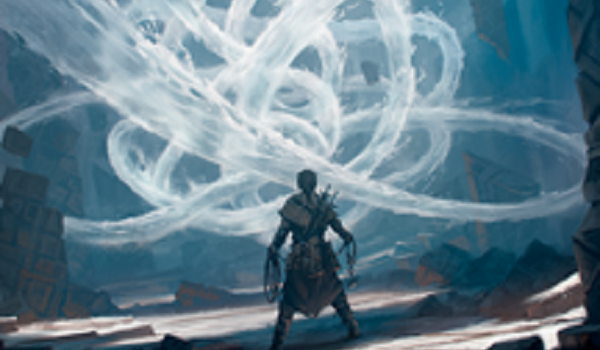



Idk, it still seems reasonable against Amulet Titan even with the situation you described. I mean, they had 5 lands in play, two scouts, an azusa, an amulet, and a bounce land and Titan in hand. That’s a tremendous amount of material to have in play to end up barely comboing off. I would argue that the card definitely still put in a tremendous amount of work there, especially as it only costs 2 mana and cantrips. Also of note, is that all that material they had on board is *still* only really relevant if they have an Amulet out. Now, the Uro decks using it to recycle Sanctuaries is definitely a side effect I had not thought of when I originally saw the card.
There’s a part of me that wants to try the Conundrum alongside the new 3-drop Archon who has a Rule of Law plus Thalia, Heretic Cathars non-basic land tapping ability stapled to it to just wreck anyone using fetchlands, but that might be too cute.
I actually did try the Archon. It’s pretty good on its own. Against any slow deck combining it with Conundrum is devastating. However, most of the time it’s way too narrow to be relevant. And a bit win more, frankly.
As I said, it only happened once, but as they say once bitten twice shy. I’m also certain that the really dedicated Amulet players will have guides to dealing with Conundrum/using to their advantage out very soon.
And yeah, seriously, don’t play it against Modern Uro. Graveyard hate is much better.
Yea I think the Archon pretty much pushes out Eidolon of Rhetoric, if anyone was still running that in the SB. I mean it dies to bolt, but it’s also a better (and evasive) clock, which I feel is what you want in a matchup where you want a Rule of Law effect.
I’m pretty desperate to beat Amulet Titan in whatever way I can. I’ve more or less tried everything I can think of. If this gives me a chance I’m all in.
I mean, if you stick a conundrum and can answer any amulets they might play, they are pretty much done. Because all the extra land drops that deck can accrue don’t mean much of anything, because they really can’t net Mana very easily.